- Publisher's Note
- Editorial
- Jogen Chowdhury: Maestro par Excellence
- Company School Paintings of Calcutta, Murshidabad, Patna (1750-1850): Doctoral Thesis of Late Dipak Bhattacharya (1960-2007)
- Kalighat Pat, a Protomodern Art Tradition?
- Academic Naturalism in Art of Bengal: The First Phase of Modernity
- Under the Banyan Tree - The Woodcut Prints of 19th Century Calcutta
- The Arabian Nights and the Web of Stories
- Gaganendranath Tagore's Satirical Drawings and Caricatures
- Gaganendranath's Moments with Cubism: Anxiety of Influence
- Abanindranath as Teacher: Many Moods, Some Recollections
- Atul Bose: A Short Evaluation
- J.P. Gangooly: Landscapes on Canvas
- Defined by Absence: Hemen Majumdar's Women
- Indra Dugar: A Profile of a Painter
- The Discreet Charm of Fluid Lines!
- Delightful Dots and Dazzling Environments: Kusama's Obsessive Neurosis
- Peaceful be Your Return O Lovely Bird, from Warm Lands Back to My Window
- Shunya: A Beginning from a Point of Neutrality
- The Tagore Phenomenon, Revisited
- The Bowl, Flat and Dynamic Architecture of the BMW Museum
- Baccarat Paperweights: Handmade to Perfection
- Byzantium and Islam: Age of Transition at the Metropolitan Museum of Art
- Outstanding Egyptian Art at the Metropolitan Museum of Art
- Retrospective of Wu Guanzhong at the Asia Society Museum
- Masterpieces from India's Late Mughal Period at the Asia Society Museum
- The Dhaka Art Summit: Emergence of Experimental Art Forms
- Many Moods of Eberhard Havekost
- Random Strokes
- Is it Putin or the Whole Russian State?
- The Onus Lies With Young India
- What Happened and What's Forthcoming
- Preview May, 2012 – June, 2012
- In the News, May 2012
- Art Events Kolkata, April – May 2012
- Mumbai Art Sighting
- Delhi Dias
- Art Bengaluru
- Musings from Chennai
- Cover
ART news & views
Academic Naturalism in Art of Bengal: The First Phase of Modernity
Issue No: 29 Month: 6 Year: 2012
by Mrinal Ghosh
 Modernity in Bengal art showed its first sign of flowering with the emergence of British academic naturalism. The beginning and development of academic naturalism was the outcome of British colonial impact and hegemony of British rule in India.
Modernity in Bengal art showed its first sign of flowering with the emergence of British academic naturalism. The beginning and development of academic naturalism was the outcome of British colonial impact and hegemony of British rule in India.
The official art policy of England during the second half of eighteenth century was dominated by British Royal Academy. The Royal Academy was established in England in 1768 under the patronization of King George III. The celebrated British painter Joshua Reynolds (1723-92) was its founder-president. He was initially responsible for framing the guide lines of the Academy and consequently the policy of art practices and art education of that country. The rendering of mirror image of nature as practiced by the renaissance painters was considered as the guiding norm of art practice. The heritage of the same naturalism was brought to our country as a colonial art policy. This art policy gained ground and proliferated through the art education devised by the Art School established in Calcutta during 1854. The emergence and spread of this first phase of modernity has a pre-history.
Western naturalism made its first imprint in Indian painting during the Mughal period at about sixteenth century. The Mughal court painters tried to assimilate to some extent the naturalistic trends of the art of European 'mannerism'. Conversely Mughal style also cast some influence on Western artists. Paintings of Rembrandt (1606-1699) revealed some traces of it. With gradual decline of Mughal Empire after the demise of Aurangajeb in 1707 the court painters patronized by Mughal monarchs disintegrated. British academic naturalism made its first foothold within this void. Its initial advent started during the reign of East India Company through the visiting British artists who came to India to make an easy fortune. The first among them was Tilly Kettle. He arrived at Madras in 1769 and then came to Calcutta in 1771, and stayed here till 1776. He was followed by John Zoffany (1783-89), Arther Devis (1785-95), George Ferrington, Thomas Hiki, Thomas and William Daniel, Francesco Rinaldi, George Chinnery (1802-25), Robert Home, John Smart (1785-95), Ozias Humphray (1785-87), Samuel Andrews (1791-1807), Diana Hill (1786-1806) et.al. Though these artists were not part of Bengal art heritage, yet their paintings made considerable influence towards propagation of naturalistic form in pre-modern and pre-art school trend of art practice. Their art also influenced the aesthetic taste of the rich and so called aristocratic people of Bengal.
Works of these European artists were instrumental in generating a semi-naturalistic style of painting known as 'Company School'. The paintings of this style were first developed at Thanjore of South India and gradually spread to other parts of the country. The Company painters were originally engaged in Mughal and various other royal ateliers. They lost their job with the decline of these patronages and came to the newly born and growing city of Calcutta and established contacts with visiting European artists. Many of them were employed by the British aristocrats and developed a style as demanded by their foreign patrons. Their inherent skill and subtlety of taste mingled with the newly earned technique of naturalism to give rise to a peculiar form known as Company Style. The Company School continued from middle of eighteenth up to about middle of nineteenth century.
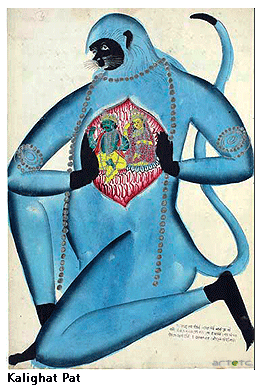
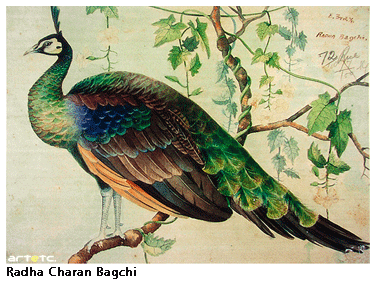 While a section of artists working under British patronage created the company School, another section of village patuas migrated to the growing city of Calcutta and congregated near the Kalighat temple and painted pictures of religious, mythical and social subjects slightly transforming their own folk style to meet the demands of pilgrims and common people who used to visit the temple. This was known as Kalighat Pat painting and has been famous as a very original indigenous style of Bengal, assimilating both folk and urban ethos. The practice of this style was, however, not limited around the vicinity of Kalighat temple only, it was practiced in different other centres of Calcutta also. Originating during early nineteenth century this style developed up to first quarter of twentieth century, after which it gradually declined. Despite some urban sensibility and rounded voluminousness in delineation of form it had very little link with the naturalist trend. Rather it had created a glorious anti-naturalist but realist original indigenous style linked with deep rooted tradition that had an enlightened impact in subsequent development of our modern and modernist art.
While a section of artists working under British patronage created the company School, another section of village patuas migrated to the growing city of Calcutta and congregated near the Kalighat temple and painted pictures of religious, mythical and social subjects slightly transforming their own folk style to meet the demands of pilgrims and common people who used to visit the temple. This was known as Kalighat Pat painting and has been famous as a very original indigenous style of Bengal, assimilating both folk and urban ethos. The practice of this style was, however, not limited around the vicinity of Kalighat temple only, it was practiced in different other centres of Calcutta also. Originating during early nineteenth century this style developed up to first quarter of twentieth century, after which it gradually declined. Despite some urban sensibility and rounded voluminousness in delineation of form it had very little link with the naturalist trend. Rather it had created a glorious anti-naturalist but realist original indigenous style linked with deep rooted tradition that had an enlightened impact in subsequent development of our modern and modernist art.
The Bat-tala wood and metal engraving developed during 1860-s and 1870-s was another trend of folk-urban style featuring special characteristics in graphic print media. These prints, though in some cases convey a sense of mass and volume, were mostly flat, decorative, two-dimensional in execution, not akin to any naturalistic form. These 'mechanical reproductions' were responsible for gradual disintegration of the practice of Kalighat paintings.
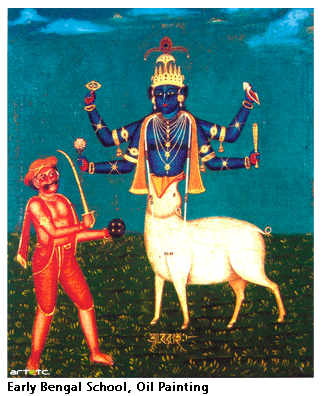 Another important trend of naïve naturalism came into being through the practice of native artists, between 1800 and a few early decades after 1900, who had come in contact with professional British artists and learnt from them the techniques of naturalist executions but could not master in all its intimate intricacies and the minute geometricity of working with perspective, yet assimilated their newly earned knowledge of naturalism with their inherent wisdom in traditional rendering to generate this new style known as 'early Bengal school'. The artists were mostly anonymous. They worked in oil on canvas or wood mostly on mythological and religious subjects. Previously these were designated as French-Bengal and Dutch-Bengal school, which has now been abandoned. They are now known simply as oils by unknown artists of Bengal.
Another important trend of naïve naturalism came into being through the practice of native artists, between 1800 and a few early decades after 1900, who had come in contact with professional British artists and learnt from them the techniques of naturalist executions but could not master in all its intimate intricacies and the minute geometricity of working with perspective, yet assimilated their newly earned knowledge of naturalism with their inherent wisdom in traditional rendering to generate this new style known as 'early Bengal school'. The artists were mostly anonymous. They worked in oil on canvas or wood mostly on mythological and religious subjects. Previously these were designated as French-Bengal and Dutch-Bengal school, which has now been abandoned. They are now known simply as oils by unknown artists of Bengal.
The purpose of opening art educational institute in India has been very explicitly stated in the Education Dispatch of East India Company of 19 July 1854. It states: 'None can have a stronger claim on our attention than … education. It is one of our sacred duties to be the means … of conferring upon the natives of India those vast moral and material blessings which flow from general diffusion of useful knowledge, and which India may, under providence, derive from her connection with England'. To the British authorities naturalism was the only true expression of fine arts. They did not consider the vast spiritual and humanist tradition of Indian art of any consequence from the view point of fine art. They categorized it as minor decorative art. It was therefore entirely discarded. Moreover through training in naturalist form their intention was to create some artist-craftsmen necessary for their administrative and other decorative works. This was the purpose of their imparting art education to the natives of India.
The first Western type art school in India was, however, opened at Poona in 1798 by a British resident Charles Malet. Run by an artist James Wales, it was very short-lived. In Calcutta the very first effort of imparting institutional art education was the formation of 'Mechanical Institute' in 1839. Colsworthy Grant used to teach here constructional drawings. Classes were held first in Town Hall, then in a premise at the eastern side of Governor's palace. But it was very short lived.
After its demise the serious and permanent venture was the formation of 'The School of Industrial Art' on 16 August 1854 at Garanhata. The purpose of opening such school was 'the humanizing the culture of the fine arts'. At first it was a privately governed institution. It started with 45 students in clay modeling and 50 students in drawing and painting. M. Rigaud was the instructor in clay modeling. M. Agyar taught drawing. After some time to accommodate more students the school was shifted to another building at Moti Sheel Street in the Kolutola area. Gradually it acquired financial grant from the government. Finally it was taken over by the Director of Public Instruction of the government. Henry Hover Lock, the superintendent of London School of Design was assigned the charge of the school on 29 June 1864. At the same time the school was shifted to 166, Bowbazar Street. In 1865 its name was changed to 'The Government School of Art'. Finally in 1951 it was upgraded as 'The Government College of Art and Craft'.
H.H. Locke was the Principal of Government School of Art for a stretch of 18 years from 1864 to 1882. He stressed on imparting art education on the basis of model of South Kensington School at London. At Kensington academic naturalism of Joshua Reynolds style was the primary norm of art practice, though other artists in England during that time were trying to come out of the strict norm of naturalism, movements of Turner and the pre-Raphaelite artists being the examples. Locke was not sympathetic to those new trends. Consequently those were not considered for imparting art education at Calcutta. Academic naturalism was taken up as the only norm, which continued unabated till 1896. In 1896 E.B. Havell joined the art school as superintendent. He made an endeavor to introduce art education based on Indian tradition. But side by side education based on academic naturalism also continued throughout twentieth century.
So during the second half of nineteenth century a number of artists proficient in academic naturalism came out from the Government art School. Among the early students of Locke, Annada Prasad Bagchi (1849-1905) and Shyamacharan Shreemani (?-1875) were two important names.
Annada Prasad was admitted to art school on 13 July 1865. He earned proficiency in wood engraving, lithography and other engraving techniques and finally learnt oil painting under Principal Locke. He earned fame for illustration of the famous book The Antiquities of Orissa by Dr. Rajendralal Mitra, which he did during 1868-69. He was a skilled portrait painter in oil. He also worked on various composition paintings based on mythical themes. In 1878 he formed 'Calcutta Art Studio' along with other students of art school like Nabakumar Biswas (1851-1935), Phanibhushan Sen, Jogendranath Mukhopadhyay and Krishna Chandra Pal. The studio played very important role in the spread of illustrated books and coloured lithographs on mythical subjects in naturalistic style among the elites and common people alike. He became a legend during his life time and in many ways instrumental in spread of academic naturalism in Bengal.
Annada Prasad was very much contemporary to another legendary figure of naturalistic painting in India, Raja Ravi Varma (1848-1906). This Kerala born painter had no institutional training. He was almost self-taught. But his skill and proficiency in academic style was widely acclaimed. He even earned international fame through his dexterously painted works on Indian mythological themes. In the context of Bengal art his importance was that through his prints and oleographs of his paintings he was instrumental in forming art awareness among a wide cross section of the people of Bengal.
Shyamacharan Shreemani was an expert in wood engraving and lithography. In 1869 he was appointed as a teacher of geometrical drawing by H.H.Locke. He was famous not for academic naturalism but how he tried to awaken an awareness about greatness of Indian art heritage. His book on Indian art theory Sukumar Shilper Utpatti o Arya Jatir Shilpa Chaturi (The Rise of Fine Arts and Aesthetic Sensibilities of the Aryans) published in 1874 was the first attempt in serious art writing in Bengal in a vernacular language.
We do not know much about the artists who were coming out of art school during its earlier years. They might have been engaged in various jobs. Very minimum of them have come to lime light as creative artists. Among the painters who have made some imprints in creativity a few of the important names are: Bamapada Bandopadhyay (1851-1932), Shashi Kumar Hesh (1869- ?), Jamini Prakash Ganguly (1876-1953), Bhabani Charan Laha (1880-1946), Gangadhar Dey, Pramathanath Mitra et.al.
Bamapada Bandopadhyay was famous not only as a portrait painter but also for his paintings on mythological themes done in academic style. The oleographs of his mythological paintings were circulated within the country four years before those of Ravi Varma. The first series of oleographs based on his paintings on the themes of Mahabharata like Arjun and Urbashi and Uttara and Abhimanyu was circulated in 1890. He is also famous for his paintings on secular themes. His oil titled Juggler and Monkey was awarded in third Calcutta Fine Exhibition in January 1879, when his age was 28. Parallel to Ravi Varma his contribution to create an excellence in naturalist form on nationalist subject was very important and far fetched.
Shashi Kumar Hesh, after his initial training in Government School of Art, went to Italy in 1894 and was trained in Royal Academy of Rome. After that he also received training at the Munich Royal Academy. Hesh was famous as a portrait painter. He painted portraits in oil and pastel in immaculate academic technique of various celebrated persons of the country among them Maharshi Debendranath Tagore, Dadabhai Nouraji, Bipin Chandra Pal, Ishwar Chandra Vidyasagar, Ramesh Chandra Dutta, Rabindranath, Jagadish Chandra Basu et. al. are important. Possibly he died during the decade of 1940-s while visiting America.
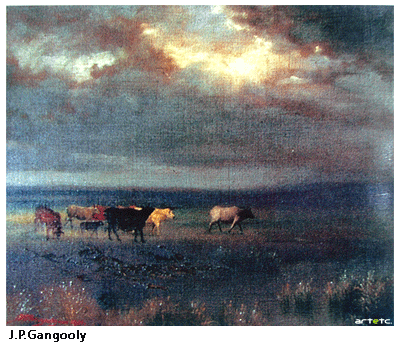 Jamini Prakash Ganguly was famous both as a portrait painter and landscapist. He was related to the Tagore family of Jorasanko and was intimate to Rabindranath and Abanindranath. Like Abanindranath he also had initial training in painting under Olito Gilardi and Charles Palmer. He was appointed Vice-Principal of Government Art School on 19 June 1916 and acted in this post till 1928. He made unparallel contribution in landscape painting, where he to some extent idealized naturalism. His landscapes of Himalayas, Bengal villages and river Padma exemplify such assimilation.
Jamini Prakash Ganguly was famous both as a portrait painter and landscapist. He was related to the Tagore family of Jorasanko and was intimate to Rabindranath and Abanindranath. Like Abanindranath he also had initial training in painting under Olito Gilardi and Charles Palmer. He was appointed Vice-Principal of Government Art School on 19 June 1916 and acted in this post till 1928. He made unparallel contribution in landscape painting, where he to some extent idealized naturalism. His landscapes of Himalayas, Bengal villages and river Padma exemplify such assimilation.
Bhabani Charan Laha assimilated naturalism with some sort of Indian sensibility. Apart from portrait and landscape painting in water colour and oil he also worked on various mythological subjects based on Ramayana, Mahabharata and other literary themes.
Among the sculptors Rohoni Kanta Nag (1868-1895) was an important figure. He is famous as the first Indian sculptor to have academic training in Italy. Within a short span of life of 27 years, he proved his talent. When he died in Calcutta on 13 May 1895 after returning from Italy, leaving behind all his sculptures and paintings there, it was Rabindranath Tagore who had to exert himself to bring back the late sculptor's works from Italy at the poet's own expense.
Other important sculptors who made who made important contribution in academic naturalism were Jadunath Pal (1838-?), Shital Chandra Bandopadhyay (1879-?), Ashwini Kumar Barman Roy (1882-?) and Hiranmay Roychowdhury (1884-1962) et.al.
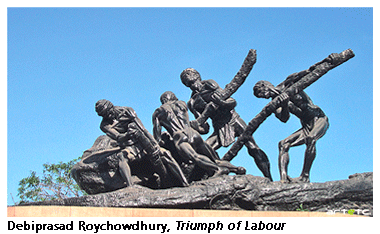
To round of the topic of sculpture let us include here the illustrious name of Debiprasad Roychowdhury (1899-1975). He was a towering figure both in painting and sculpture. As a painter he was trained under Abanindranath and expanded the horizon of neo-Indian school of painting. As a sculptor he was confined mostly within naturalism, occasionally infusing influences of Rodin and Bourdel with a romantic fervor. Debiprasad was a significant portrait sculptor. Only in later life he created a few composition sculptures like Triumph of Labour (1954), When Winter Comes (1957), Martyrs Memorial (1956) etc.
Since the inception of 'School of Industrial Art' in 1854 trends of academic naturalism went unabated among the art school trained artists. It was stalled when E.B. Havell (1861-1954) took charge of the Art School as Superintendent on 6 July 1896. He questioned the validity of art education to Indian students through an alien naturalistic form and professed that art education should generate from the indigenous traditional root. So discarding training in academic naturalism he introduced training in Indian traditional norm of painting. This was the period of nationalist movement in Bengal. Awareness was growing in all corners of society against colonial hegemony. Even before coming of Havell, Abanindranath, though initially trained in academic naturalist art, started his search for an Indian identity in his painting. This awareness gradually spread into a movement of the neo-Indian school.
But this nationalistic spirit was not accepted by all. There rose a protest among the art school students against indiscriminate indianisation of art education discarding academic naturalism. Lead by Ranada Prasad Gupta (1870-1927), a third year student of the art school, they formed 'Jubilee Art Academy' at Baithakkhana Road of Calcutta in 1897. Its purpose was to intensify naturalist training in art education. Number of students who in later life became famous as artists was initially trained in this institution. Among them some of the important names are Narendranath Sarkar (1881-1943), Phanindranath Basu (1888-1926), Jogendranath Shil (1895-1926), Atul Basu (1898-1977), Basanta Kumar Ganguly (1893-1968), Hemendranath Majumder (1894-1948), Pramathanath Mallik (1894-1983), Abhay Charan Das (1886-1956) and Prahlad Chandra Karmakar (?-1946).
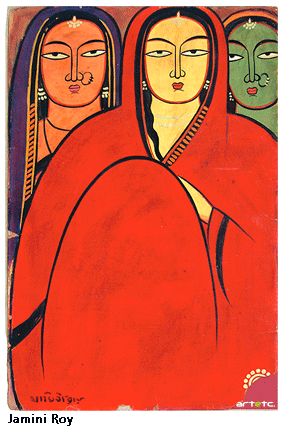
Among all these artists special mention should be made of Hemendra Nath Majumder and Atul Bose. Hemendranath's mastery over execution both in oil and watercolour is exemplary. He heightened physical sensuousness to a superb aesthetic level. Mainly famed as a portraitist Atul Bose's few works on Bengal famine of 1943 and number of his landscapes show how he could amalgamate naturalism and realism. Jamini Roy (1887-1972) in his early works showed great skill in naturalism. Being inspired by nationalist feelings he gradually shifted to folk idioms to build up an indigenous identity. But his proficiency in naturalism and post-impressionist technique added a lot in formation of his original style.
Through these artists, naturalistic trends were carried up to 1940-s and beyond. Even today it exerts considerable power in building up forms of contemporaneous value. Naturalism, despite various projects of defying and surpassing it in different phases, has turned out to be a vital idiom in the formation of our modern and modernist art.